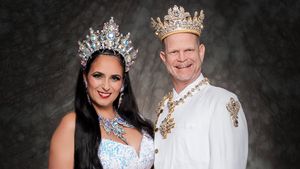Amidst a global health pandemic and the onslaught of racist, violent attacks against Black people at the hands of the state, the Department of Education continues to quietly chip away at students' rights. While students all across the country took to the streets to stand in solidarity with Minnesota protestors, Secretary of Education Betsy DeVos and the Department of Education were busy threatening to pull federal funding from schools in Connecticut that allow trans athletes to compete on sports teams that align with their gender identity.
LGBTQ+ students -- especially Black and Brown ones -- have always faced astronomical barriers to safe learning environments. Title IX, the federal law prohibiting sex discrimination in schools, has historically guaranteed that students' status as queer and as trans does not interfere with their ability to access education. In an effort to clarify those protections, the Department of Education under the Obama administration released a guidance that said prohibiting trans students from using facilities that align with their gender identity violates federal anti-discrimination laws. This guidance also made it more likely to ensure trans students were addressed by their correct names and pronouns and treated consistently with their gender identity. But even with that guidance published, few students knew about the rights they have, and even fewer had the tools to defend them. Now, the situation has gotten worse.
One of the first things Betsy DeVos did upon taking office in 2017 was rescind that guidance, leaving trans students in the lurch, and last week, they took it a step further. While activists across the country took to the streets to protest police brutality and other forms of anti-Blackness, student survivors of sexual assault watched the Department of Education roll back their rights, and a global pandemic claimed hundreds of thousands of lives, the Department continued to go to new lengths to harm trans students. The Trump Administration's ruling against Connecticut's trans-inclusive policy demonstrates their lack of support for schools and districts that are looking to keep trans students safe and included in their own schools. In doing so, the Department has once again used a law meant to prohibit sex discrimination, torequire it.
Connecticut is one of 19 states that require schools to allow transgender student athletes to compete on sports teams consistent with their gender identities. In the fall of last year, three cisgender Connecticut girls who had lost competitions to transgender athletes filed a complaint with the Department of Education's Office for Civil Rights arguing that by respecting transgender students' identities, Connecticut schools discriminated against cisgender student athletes. The Department responded last week by agreeing with those girls. This move contradicts countless court decisions protecting trans students, especially a 2017 decision in which the Seventh Circuit Court of Appeals clarified that Title IX does indeed protect trans students against discrimination. Still, the Department has now warned the schools that this policy of inclusion will be punished by withholding federal funds. In short, the government is threatening to punish schools for providing inclusive school environments.
Trans Americans have experienced major signs of progress as well as many setbacks these few months. Many people are celebrating this week's 6-3 Supreme Court ruling that determined Title VII of the 1964 Civil Rights Act includes protections for workers based on their sexual orientation and gender identity. Unfortunately, this decision comes right on the heels of the U.S. Department of Health and Human Services' release of their final rule on Section 1557. This legally binding rule, which was released on the four year rememberance of the Pulse shooting, revoked provisions present in the 2016 rule that prohibited discrimination based on gender identity, now states sex discrimination will be limited to one's sex -- male or female and as determined by "biology." This decision does not take into account the complexities of sex and gender and leaves room for a legal interpretation that does not protect transgender patients again discrimination in the medical field.
These two decisions have very different interpretations of how trans people will be protected under the law in the future. While the HHS rule, which was released before the Supreme Court decision claims sex discrimination is only relevant in regards to one's "biological sex," Supreme Court Justice Neil Gorsuch argues differently. In his majority opinion statement he claims, "It is impossible to discriminate against a person for being homosexual or transgender without discriminating against that individual based on sex." That argument may allow for changes in favor of trans rights in not only the Health and Human Services realm of politics, but also Title IX.
Unless students are paying close attention, generally, it's hard to follow all of this as the definitions under Title IX, and the Department of Education's guidance gives mixed signals. Just a few weeks ago, the Department dropped 2,000+ pages of legalese muddying the landscape of student survivors' rights. The final rule, which alters schools' obligations in responding to complaints of sex discrimination, including sexual harassment and assault, confounds even legal scholars. And it's especially confusing for trans students and advocacy groups, given that those thousands of pages sidestep the topic of trans students' rights altogether. The Department's Office for Civil Rights (OCR) website clarifies nothing. It mimics Obama-era language stating that "Title IX protects all students, including LGBTQ students, from sex discrimination," but then OCR turns around and threatens to punish schools, like the ones in Connecticut, that protect trans youth from discrimination.
These protections are critical to ensuring trans students can equally access education. According to GLSEN's 2017 National School Climate Survey, students who attend schools with formal policies and practices to protect trans and gender-nonconforming students were less likely to experience harassment and discrimination, they were also less likely to miss school due to fear of safety, had higher post-graduation aspiration and stronger school performance.
At its core, Title IX is intended to ensure that gender discrimination and harassment never stops someone from succeeding in education -- including trans students. We cannot let Betsy DeVos and her Department of Education use Title IX as an avenue to discriminate against us based on our gender. It's a manipulation of the law and an insult to previous administrations, and courts, that have affirmed LGBTQ+ students' rights under the law. When the Department of Education under DeVos rescinded the 2016 guidance on transgender students under Title IX, there was no Supreme Court ruling substantively linking sex and gender-based discrimination to queer and trans people -- but now there is. Now is the time to take action and work to ensure inclusion for all young people in their schools.
As a queer Black student in America, I often feel as if I'm being pulled in many directions at once and the past few days are a perfect example. We are in the middle of a global health pandemic. Because my friends are currently spread all across the country, I spend my time coordinating with other queer Black folks to make sure everyone stays safe as we fight for our lives in our hometowns. Every night, I check in to make sure all my people are alive and accounted for, and then turn back to organizing. We as young people are busy making sure our communities have bail funds and resources, and that organizers have safe houses and first aid supplies. For the Department of Education, in the midst of everything else happening right now, to keep quietly stripping trans students of our rights and federal protections is inhumane. This is not the brand of leadership I or the majority of the country voted to see in governmental positions of power.
Reflecting on the past year, I cannot help but be so proud of the organizing and activism that queer young people have engaged in all across the country. However, as a trans student who engages with Title IX activism, I know we can be doing more. As queer folks, we cannot leave the fight to improve Title IX protections to survivors of sexual assault alone. The Department of Education continues to utilize Title IX in a way that infringes on trans students' ability to live and learn, and attempts to pit communities against each other. Our fight for equal protection under the law is not disconnected; it is founded on the same grounds that all of us are deserving of legal protections, support, and resources in this country.
We must take up this fight to ensure survivors and transgender students are protected in school. June is Pride month and while many queer folks are understandably disappointed that we are unable to gather and celebrate with our friends and chosen family, I hope we can take this time to engage in coordinated organizing efforts. Pride started as a riot; in my mind the best thing we can do to honor that legacy is to continue fighting for our rights.
As students, we owe it to ourselves to take our rights into our own hands. We need to push for the 2016 guidance for trans students under Title IX to be reinstated, pressure the Department of Education to stop their threats to withhold federal funding to schools who protect trans students, and demand our schools protect the rights of trans students -- even if the Department of Education won't.
Ose Arheghan is a GLAAD Campus Ambassador.

















































































